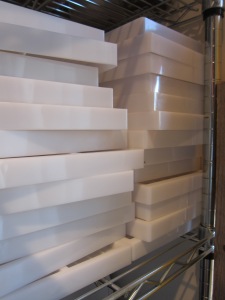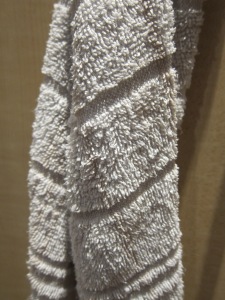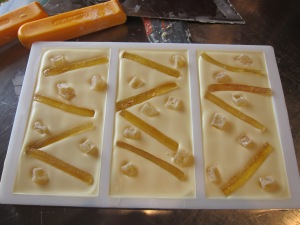I have quite a selection of different types of molds and thought it might be interesting to look at each type.
I’ll do several posts to cover them all but today I’m going to look at my favourite, and the one I work most with – my polycarbonate molds. While I have different shapes in these the ones that I use most frequently are my 100 g bar molds.
The ones I use are from Keylink and you get 3 of the shapes in the one mold. They have proven sturdy and long lasting – which is good as they’re not cheap, particularly when you’re looking at the 3D molds for Easter eggs and the like. If you take good care of them they should last a lefteime.

In the above picture you can see some of mine stacked and ready to go.
When I’ve been to other chocolate venues where you see the chocolatiers at work you’ll see the molds left unwashed and left with chocolate all round them and looking really unclean. There’s a reason for this; the chocolate lifts cleanly from the mold and leaves the mold clean (as least it is if it’s properly tempered, it can stick and leave residue if not tempered properly) and any left will prevent the next lot sticking to it, a bit like a wok building up a good working layer.
The issue I have is that :
(1) I don’t have a huge quantity of molds to work from, and you’d need to keep each colour of chocolate being used consistent with your molds (as you scrape off the sides of the mold to clean it up before letting the chocolate in it to cool.) If you didn’t you could end up having white in with dark – thus making dark chocolate have dairy in it when you might not want to due to allergy reasons, unless you have a policy to only use one type of chocolate in a set of molds.
(2) I work with strange flavours, so even keeping like with like in regards to type of chocolate being consistent, I’d have to extend this to flavour of chocolate being used having to be consistent; I’d end up needing an extra room to store all my molds!
This just isn’t practical for me, so I wash my molds between batches. This isn’t as straightforward as it sounds – there’s a knack to this. If you put molds in the dishwasher they come out blotchy – this stops the chocolate looking smooth, shiny and professional when it comes out of the mold.
I tend to hand wash mine, in approved detergent, then rinse well, then dry. I only wash 2 at a time because you have to dry them quickly – or they get blotchy looking. So wash, rinse dry, 2 at a time, 2 by 2, much like the animals in the Ark, or for those with a sci- fi bent of mind, like River in Firefly (“Hands of blue, two by two”).
Even the cloth to dry them makes a difference to a good finish, I find that the toweling ones are great for drying into all the corners and give a good polish and shine to the mold.

The linen ones work well for a couple then tend to smear I find, don’t know why, but they do. You don’t want to scratch your molds as any scratches will show up in your finished bars, that’s why polycarbonate is good as it is resilient. If you’ve used a dishwasher you can always polish up the molds with kitchen roll. I tend to use couch roll as I already have it due to the massage side of my life!
When making the bars, the mold is tapped at its’s sides or underneath, with your scraper to release air bubbles, so you want a strong mold that won’t scratch or shatter.
You know when the chocolate is ready to come out of its mold as it contracts as it cools, leaving a slight line like a crack between the chocolate and the mold, you might see it in the picture below…?
Simply up end the mold, tap it out gently and the chocolate should release easily and fall out.
Simples 🙂
I found this great YouTube demo with Jacques Torres of filling the mold and discussion of the molds at the start, it also show the tapping to release bubbles, have a look here and here (the latter links shows Chef Derrick Tu Tan Pho demonstrating chocolate molding technique at the eGullet Candy and Confectionery Conference 2011.)


